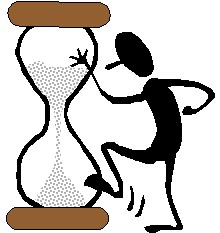-Reinforce the student every time period that the behavior is displayed (e.g., minute, hour, class period)

Schedules of Reinforcement
Given the precise and structured nature of the procedures of applied behavior analysis, you can be sure that any self-respecting behaviorist would make sure to "catch kids being good" only under certain circumstances (like in the Differential Reinforcement procedures) and on a particular schedule. By implementing a certain schedule when first building a behavior, and later changing to other schedules, you can promote stronger, more ingrained versions of appropriate behavior while "weaning" kids from rewards. Below, you'll find information on the different schedules and when you might make use of them.
Continuous Schedule
When you are first trying to get a youngster to start displaying a behavior that, at present, is nonexistent (or nearly so), you'll want to catch him/her being good (give a reward/reinforcement) each and every time that the behavior is shown. This pupil needs immediate positive feedback in order to recognize the benefits of displaying the behavior. You might have to prompt (spark) the behavior to happen with a direction, hint, or cue. When the student shows the desired behavior, give reinforcement right away. This may mean that you will need to ask other students to wait, even though they sought your attention first.
For example, supposed you are trying to get Karen
to raise her hand to seek assistance. Despite telling her what to
do, when frustrated, she says out loud "Mr. El-Hifnawi,
I need your help." Mr. E-H. says "How
did we say that you should ask for help?" After appearing
perplexed, she then gives a sudden look of recognition and immediately
raises her hand. Mr. E-H. goes directly to her to offer his help
because he knows that Karen needs immediate reinforcement right now if
she is going to be motivated to show the behavior again in the future.
Now suppose that three other kids already had their hands up to seek assistance.
Mr. E-H. would say "Henrietta, Ian, and Elena, I'll
be right with you." as he approaches Karen. It may seem unfair,
but if need be, Mr. E-H. can take the time later to explain to the others
why Karen was approached first, and compliment them on their appropriate
behavior and patience.
Ratio version (having
to do with instances of the behavior)
-Reinforce/reward the student every time an action or
behavior is demonstrated
Interval version (having
to do with the passage of time)
-Reinforce the student every time period
that the behavior is displayed (e.g., minute, hour, class
period)

Fixed Schedule
Once the student is starting to display the behavior
on a regular basis, it's time to "fade out" the reinforcement by making
him/her work harder for the reward. This is done by designating a
certain number of times/time periods that the youngster must display
the behavior in order to obtain the reinforcement. For example, now
that your student is submitting homework every day for a reward, you will
"up the ante" so that now s/he must submit two homework assignments for
the reinforcement, then three, etc.
Fixed ratio version (having
to do with instances of the behavior)
Reinforce the student every so many times (e.g., every
third time, every 5th time)
Fixed interval version (having
to do with the passage of time)
Reinforce the student every so many time periods (every
third 10-minute period that the
behavior has
been shown)
Variable Schedule
Now that your pupil is doing well and displaying the behavior on a regular basis, it's time to move to the most advanced schedule of reinforcement. The variable schedule is the strongest schedule in that it strengthens the behavior even moreso than the others. This is the schedule that leads to permanence of the behavior. The variable schedule involves the "random" awarding of a reinforcer. The student doesn't know when s/he will be reinforced, so s/he continues to show the behavior in hopes that the next time will be "the charm" and bring the reward. Before the implementation of this schedule, you will predetermine when the kid will receive the reward. It will average out to every 3rd or 5th or 10th time, but be "mixed up" so that the presentation of the reward is unpredictable. For example on a "V5" schedule, you'll give a reward on the average of every 5th time, so out of 25 displays of the behavior, you might reinforce the youngster on the 2nd, 9th, 14th, 22nd, and 24th times that the behavior is shown (5 times out of twenty five times = an average of every 5th time).
Activities
1. Identify which schedule is being used and whether it is the ratio or interval version.
a. The "pay out" of money on the slot/poker machines/"one
armed bandits" on which
people gamble at casinos.
b. Every time Antonio, a student with autism, says
his name and address when prompted
to do so by the teacher, he is given his favorite reinforcement; a raison.
c. A man continues to use the same old pick up
lines in the bar even though he is rejected
by almost every woman who hears it.
d. Tasha, a young woman with moderate mental retardation,
is given a "credit" (equal to $1)
for every 100 labels she glues to bottles in the sheltered workshop setting.
e. A teacher ignores Tim's "calling out" of the
answers almost every time.
f. A bell goes off at random times in the classroom.
Tina is rewarded if she is "on task".
2. Devise an example for each version of each schedule.
![]()
| Fetch Dr. Mac's Home Page |